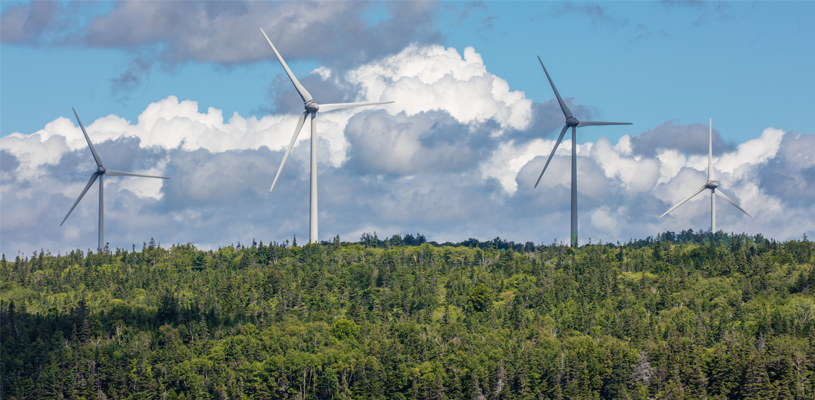A little more current

The 60-megawatt McLean’s Mountain Wind Farm can be viewed from the highest point on Manitoulin Island at the height of the Cup and Saucer Trail, a limestone bluff extending north from the Niagara Escarpment beyond the Bruce Peninsula. Michigiwadinong is the Ojibwe name for the site, a sacred place mindful of the form of spear heads. It was here that community chiefs were buried for generations, according to M’Chigeeng Elder Alma Jean Migwans.
The United Chiefs and Councils of Mnidoo Mnising (UCCMM) First Nations, based in M’Chigeeging, have put together an equal ownership partnering arrangement with Northland Power to harvest electrical energy using 24 General Electric (GE) wind turbines. The turbines are located on a ridge of land for which the UCCMM are stewards. Northland works with the community to maintain the turbines and arranges for the energy to be fed into the provincial grid to precise specifications mandated by the province.
As Elders and Knowledge Carriers at the Indigenous Sharing and Learning Centre at Laurentian University in Greater Sudbury have commented, there is a long tradition of such arrangements among communities involving natural resources being used in ways that are reconciled with all that nature provides. Respecting the limits of what is offered and received is a key part of having enduring, fruitful arrangements.
Demand for Electrical Energy Skyrockets
The demand for electrical energy for the transportation sector alone in Ontario is expected to skyrocket from 900,000 megawatt hours in 2023 to 26,000,000 megawatt hours in 2042. That’s roughly a 30-fold increase in just under 20 years.
This projection is largely based on the seismic shift from internal combustion engine (ICE) powered vehicles to electric vehicles (EVs) already underway. Automaker Ford has already announced significant shifts from ICE manufacturing to systems and components for EVs. The federal government is fueling this transition in energy demand with a hard mandate to have all cars in Canada be zero-emission vehicles by 2035.
Ontario is looking to accelerate IESO efforts to arrange for substantially more power to address even the low end of the power demand increase projected for the years ahead. Adding to the challenge is the amount of existing generating capacity going offline. The decommissioning of reactors at Pickering and the refurbishing of the rectors at Darlington are not expected to be completed until 2026. Bruce Power reactors, which reportedly meet 30 percent of current power needs in Ontario, will also require refurbishment in coming years.
Today, the energy supply mix in Ontario is led by nuclear, followed by hydro, natural gas, and wind, which is now responsible for 1,000 megawatts. Other First Nations continue to partner with developers to bring more wind projects online.
The Henvey Inlet Wind Project on the eastern shore of Georgian Bay generates 300 megawatts for the provincial grid. The project is a collaboration of Nigig Power Corporation, representing the Henvey Inlet First Nation, and Pattern Canada, a wind power operator that has the Canada Pension Plan Investment Board as its majority shareholder. The Six Nations of the Grand River Development Corporation is also in a joint venture with Pattern Canada and Samsung Renewable Energy, operating 67 Siemens turbines along the north shore of Lake Erie where the Six Nations are stewards of the land. Components were manufactured in Windsor and Tillsonburg. The total energy supply is in the order of 150 megawatts. The Batchewana First Nation is collaborating with BluEarth Renewables on the 60-megawatt Bow Lake Wind Farm northeast of Sault Ste. Marie, which features 36 turbines.
Wind farm projects are not without risks. The Canadian Wind Farm Database, maintained online by the Government of Canada, lists 10 turbines as having failed or fallen in Ontario, out of a total of 2,663 in operation. Still, the vast majority of components are reliably in operation for 25 years, and most are recyclable.
Other Generation Opportunities and Challenges
The challenge of meeting the staggering load demand projected by IESO requires a fulsome plan. Strategies being considered include small modular reactors (SMRs). Ontario Power Generation (OPG) has brought GE Hitachi Nuclear Energy onboard as a technology development partner to bring an SMR online at the Darlington Nuclear Generating Station, scheduled to be operational by 2030. According to The Narwhal, SMRs are already in the planning mix at the Canadian Ministry of Natural Resources, as well as in Alberta, Saskatchewan, New Brunswick, and Ontario. Each SMR is the size of a shipping container and can be transported overland by rail flatbed or overseas by ship. The power output from an SMR is in the order of 300 megawatts. By comparison, the Bruce Nuclear Generating Station has an output just over 6,200 megawatts, supplying just under one-third of the power for Ontario today.
SMRs utilize uranium to generate electrical current. When the fuel rods deplete below the level of ability to generate electrical flow, the rods can be changed out. The spent rods continue to be radiant well beyond this point, as is the case with all fuel rod bundles that feed much larger generating operations. The Darlington plant includes a storage facility to sequester spent bundles for the foreseeable future. It basically looks like an Olympic-sized swimming pool with the bundles submerged. Work is also underway to locate a deep storage facility elsewhere in Ontario.
The risks with nuclear SMRs are manageable due to the smaller scale of the reactors and simpler technology being developed, as compared to relatively permanent and more complex facilities such as those along Lake Huron and Lake Ontario. Upstream of the reactors, however, the extraction and refining of uranium continues to include challenges, particularly in the storage of waste ore, or tailings.
In A Closer Look at Uranium Tailings, the Canadian Nuclear Safety Commission reports that tailings deposits are being studied to better understand how they can be managed to reduce risks to humans and the environment. Dewatering, the process involving the removal of most of the water mixed with mining waste solids, allows for the remaining solids to be stored in more stable conditions. Re-processing of uranium tailings also presents the opportunity for extracting further productive material from the stored ore.
In efforts to reduce tailings generally, the mining industry is also now using processed, dewatered tailings mixed with binder pastes to repack or backfill existing spent mining stopes or tunnels in underground operations. This sequesters waste material in the original mining site and enables new tunnels or stopes to be opened above and below the repacked stope. This can significantly increase output from existing sites, assisting in recovering the costs of dewatering and repacking. However, several questions about the environmental viability of SMRs remain. It also appears highly probable that mining operations in remote locations will consider SMRs to energize extraction and processing operations as the industry moves to electrify.
The IESO is also looking at additional run-of-river and solar energy projects. Several run-of-river initiatives will require expediting of environmental studies to bring them online. Solar photovoltaic and solar thermal systems are increasingly being incorporated into real estate projects. The cost of solar photovoltaic components continues to fall substantially with increased production and use. Geo-exchange systems – transferring heat to and from well systems built into the ground – are also being examined as contributors to the energy supply.
Completing the Energy Supply Puzzle
Ontario is looking to substantially increase its energy supply up substantially to address the increase in electrical energy use in all sectors. Building energy retrofits for existing buildings and other conservation measures continue to hold great potential. In the case of the retrofit of an 80-year- old heritage home in the Haute-Ville neighbourhood of Sudbury, undertaken as a research project at Laurentian University, the combination of achieving R50 insulation values in walls and roof, the use of natural ventilation with vinyl sealed double glazed vertical hung windows, and the installation of a hot water piped heating system with zones for each floor and underfloor heating for bathrooms, resulted in a 90 percent energy use reduction. Conservation continues to be a viable partner in addressing the projected energy demands of the province.
The final piece of the energy supply puzzle rests with external partners. According to the Ontario Clean Air Alliance, a strategic alliance with Hydro-Quebec (HQ) would enable excess renewable energy produced in Ontario to be stored or used by communities in Quebec. Conversely, Ontario would have opportunities to receive clean energy from HQ where over 90 percent of the electricity is produced by hydro-electric generation. Sophie Brochu, the Chief Executive of Hydro-Quebec, is advocating for a national energy plan that looks to such alliances to successfully transition to a fully de-carbonized, electrified economy. They can look to the UCCMM First Nations’ equal ownership partnering arrangement at McLean’s Mountain Wind Turbine as an example. The view from the Cup and Saucer is heartening. MW
✯ Municipal World Insider and Executive Members: You might also be interested in Ibrahim Daair’s article: Electrification powering Kootenays clean energy transition.
Ted Wilson is an Architect teaching northern building design and environmental performance at Laurentian University’s McEwen School of Architecture in Greater Sudbury, Ontario.
Related resource materials:



